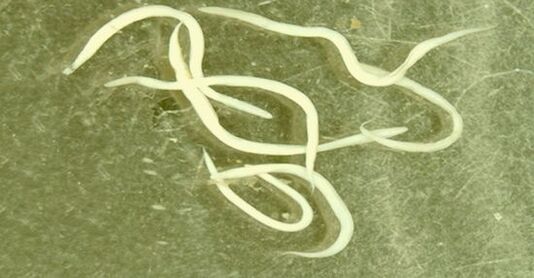
Many people are surprised to learn that one is constantly "not alone" living. Microorganisms are constantly present in itself as well as in the body, and without this mutually beneficial coexistence, man would be seriously ill and unable to survive. So there is a normal microflora on the surface of healthy skin that protects it from the growth of harmful microbes. In the vagina of women, there are lactobacilli or Dederlein chopsticks that form a normal acidic environment. Finally, there are hundreds of billions of microorganisms in the colon and feces of a healthy person that are involved in digesting food, producing vitamins, and protecting people from disease.
But,With the exception of microbes, all other random organisms - protozoa as well as worms - are parasites. . . Some begin to multiply, "poisoning" our bodies. How can parasites be detected in the human body?

This question is by no means idle. Of course, if the doctor points his finger and tells you what parasites live in that person’s body, that patient will immediately go for tests. The same will happen if, for example, small worms are accidentally found in fresh feces. The question is clear: the helminth invasion is obvious. All that remains is to clarify the diagnosis and start treatment.
However, parasites have learned to "keep their noses away, " and their presence in the body often causes incomprehensible changes that the patient does not associate with the presence of parasites at all. What are these symptoms? For example, how is chronic helminthiasis suspected?
Common signs of parasites
A whole range of parasitoses, from random (transient) to parasites permanently living in the human body, are manifested by a few symptoms. They can be divided into two groups:
- special(characteristic of a particular parasitic species), such as swelling and muscle pain with trichinella, development of acute appendicitis when entering the ascaris appendix, or excruciating itching in the perianal region in the presence of pinworms.
But it is good to have such a symptom that accurately indicates the cause of the invasion (called pathognomonic in medicine). But how can the presence of parasites in the human body be determined in the absence of such direct signs?
To do this, check for other symptoms typical of parasitosis - not specific.
- not specificsymptoms are signs that indicate poisoning of the body by the waste products of worms and protozoa.
However, these signs most often take the form of two syndromes:
- an allergic reaction of the body to a parasite;
- poisoning syndrome or poisoning.
How can parasites be identified in the human body and what symptoms do they cause?
The most common symptoms of parasitosis
- a gradual but continuous progressive decrease in body weight that is not accompanied by chronic stress, an increase in physical activity;
- the appearance of insomnia. This can be caused by both itching of the skin and the release of toxins, such as during the migration of larvae. In this case, the person simply experiences a deterioration in well-being in the evening and at night.
- the appearance of nausea and vomiting, sometimes due to aversion to food;
- anorexia, or a significant decrease in appetite, to its complete absence, including complete absence. For example, in giardiasis, children are often averse to food;
- pronounced weakness, weakness, decreased performance;
- daytime drowsiness appears;
- the temperature rises to subfebrile numbers (37, 1-37, 5);
- there is a cephalg syndrome: a headache appears that is not associated with physical and mental stress.

Allergic manifestations of helminthiasis may vary. Hives may occur, unexplained itching and disappearance of skin, allergic Quincke edema, bronchospasm may occur.
In this case,if you or a loved one has any of the above symptoms, see a doctor. . .
Of course, this does not limit the range of symptoms, but they are the most common.
About laboratory signs
How can simple tests identify parasites in the human body? For example, when studying the results of a general blood test, the following findings indicate a helminthic invasion:
- anemia, or a decrease in hemoglobin and color index levels;
- eosinophilia. . . Normally, the number of eosinophils does not exceed 5% and their number increases with parasitic diseases.
Of course, you should not do all the tests one after the other on your own, your doctor will know better what to prescribe in each case.
About random finds
Sometimes a random finding helps identify the presence of parasites in the human body. How does this happen?
- for example, fluorography finds an unusual darkening of the lung field that may prove to be a parasitic cyst;
- single or multiple cysts can be detected on MRI of the brain, often without symptoms.
In conclusion,upon detection of these symptoms, a specific diagnosis is made: they adjust the immune responses, analyze the stool and, if necessary, take the contents of the duodenum. Of course, life history is very important. So, if a person rested in hot countries in Asia and Africa the day before and swam where it was not recommended, or used water of dubious quality or unwashed fruit, the presence of a helminthic invasion is more than likely.

Similarly, if a child has similar symptoms after attending school, kindergarten, and parents are confident that the cause is not a stressful condition due to the influence of an organized team, there is more than enough reason to visit a pediatrician. infectious disease specialist.
The identified helminthiasis is treated in a special helminthology (parasitology) room, which usually exists in each regional center of the main infectious hospital.



























